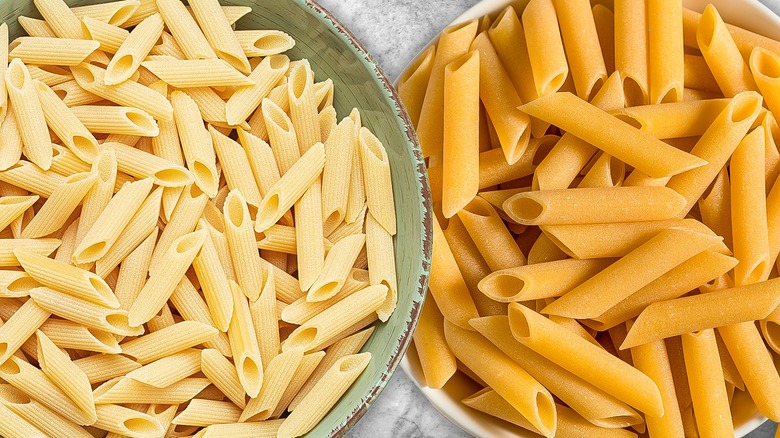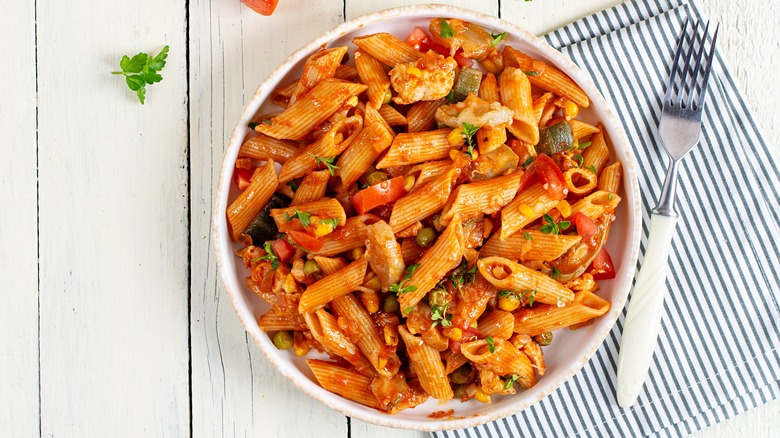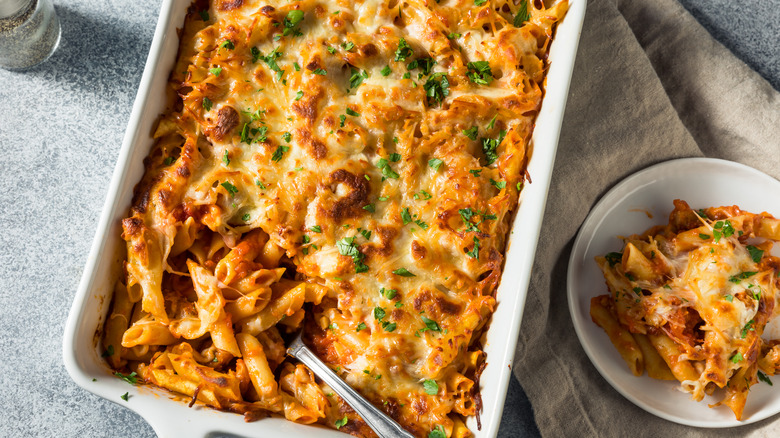Penne Rigate Vs Mostaccioli: How Do These Italian Pastas Differ?
It isn't always easy to figure out the best pasta shape for a given dish, but lucky for you, Mashed put together a guide to pasta shapes and when to use them. Among these shapes are tube pastas, which are perfect for holding onto sauces. Some of the best-known are penne, rigatoni, and ziti. Penne, which translates to "quills" in English, is so named because the ends of the pasta are shaped like angled quills or pen points, unlike rigatoni and ziti, which have flat ends.
Using that angled shape as your rule of thumb for identifying penne may leave you scratching your head when you see mostaccioli. This pasta is also tube-shaped with an angled end, so what gives? When you think of penne pasta, you're likely thinking of penne rigate, in particular. "Rigate" is Italian for striped, a reference to the pasta's ridges. Mostaccioli, on the other hand, is a smooth pasta with no stripes or ridges. Further, mostaccioli pasta is also known as penne lisce. "Lisce" is Italian for smooth, which makes penne lisce translate to "smooth quills," while penne rigate translates to "striped quills."
These two pasta shapes differ in more than name and outer texture, though. While both are Italian, they hail from different regions of the country. Furthermore, those outer texture differences — ridged versus smooth — mean each is best suited for a different application.
Penne rigate is perfect for thick sauces
The truth about Italian food, including both penne rigate and mostaccioli, is that it's vastly different across the country's different regions. Penne rigate, arguably the most recognizable form of penne, comes from northwest Italy, specifically Genoa. Incidentally, this is also where pesto got its start a few centuries earlier. It's no wonder, then, that penne rigate is well-suited to thick sauces like Alfredo, meat sauces, and the aforementioned pesto.
The ridges of the pasta hold onto those thick sauces better than smooth pasta, making penne rigate ideal for everything from creamy and tomatoey pasta alla vodka to a super meaty pasta bolognese. Alternatively, you could go down the Alfredo route with a thick, white cream sauce paired with chicken or shrimp. Sure, it's a departure from the expected fettuccine, but between the tubes and ridges, you'll get more of that delicious sauce in each bite than you ever thought imaginable.
Baked mostaccioli has found acclaim in the Midwest
Mostaccioli pasta hails from Southern Italy, specifically the Campania region, which includes Naples and the Amalfi coast. This region is known for fruits, vegetables, fish, and cheese, so it's no surprise that the tubular pasta that originated there is well-suited to light sauces like those made primarily with tomatoes and olive oil. It's also great for pasta salads — next time you make our grilled summer vegetable pasta salad, try using mostaccioli rather than penne rigate to let the vegetables shine. While the smooth pasta won't grab onto thick sauces like penne rigate, the tubular shape will still let delicious, thin sauces soak right in.
If you're still after a red sauce, then it's time to try baked mostaccioli. While we've established that mostaccioli originated in Southern Italy, baked mostaccioli has become something of a regional dish in the Midwestern U.S. That's not to suggest that the Midwest invented baked mostaccioli (pasta al forno also originated in Southern Italy), but it has found a certain acclaim in middle America. Based on Midwestern experiences discussed in online forums like Reddit, Italian Americans in the Northeast seem to prefer baked ziti while Italian Americans who made their way to Midwest cities like Chicago and St. Louis love mostaccioli and serve it at functions like fundraisers, church dinners, graduation parties, and more. Why not make our baked ziti recipe with mostaccioli pasta and see what all the fuss is about?


